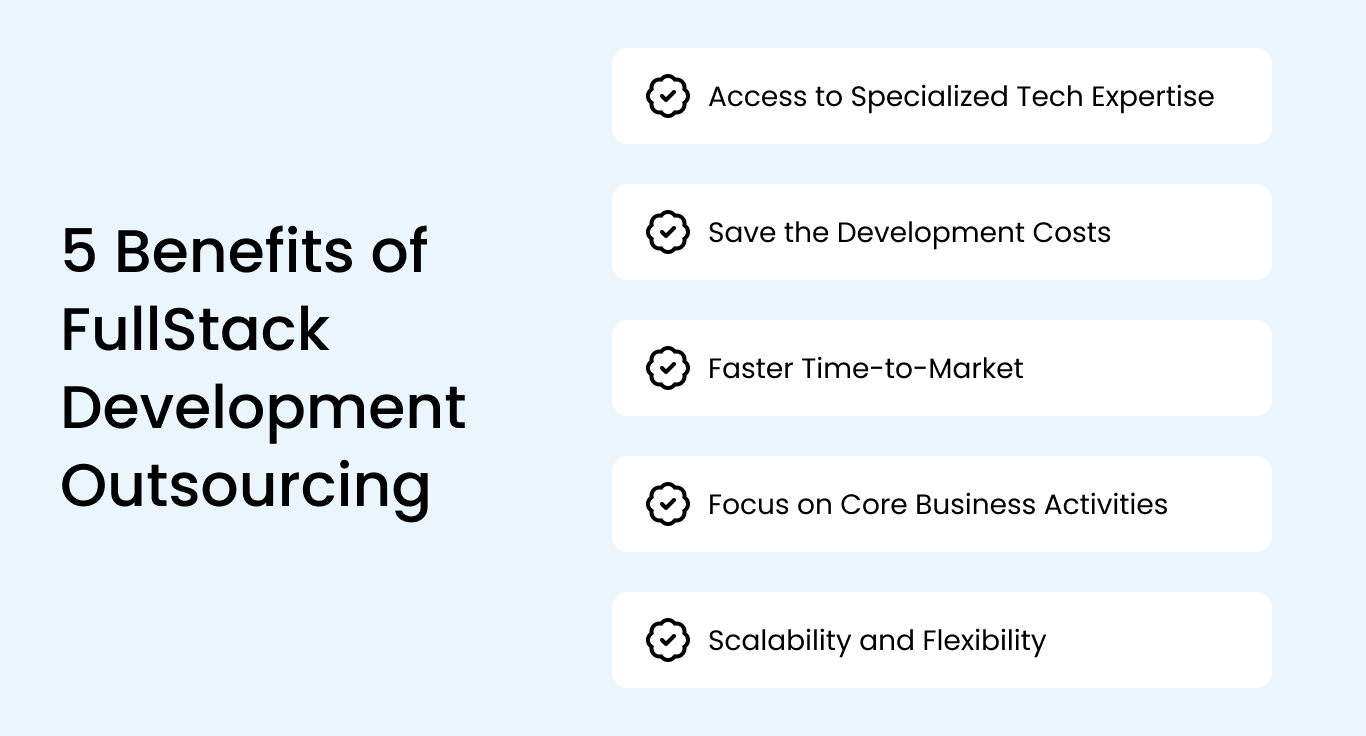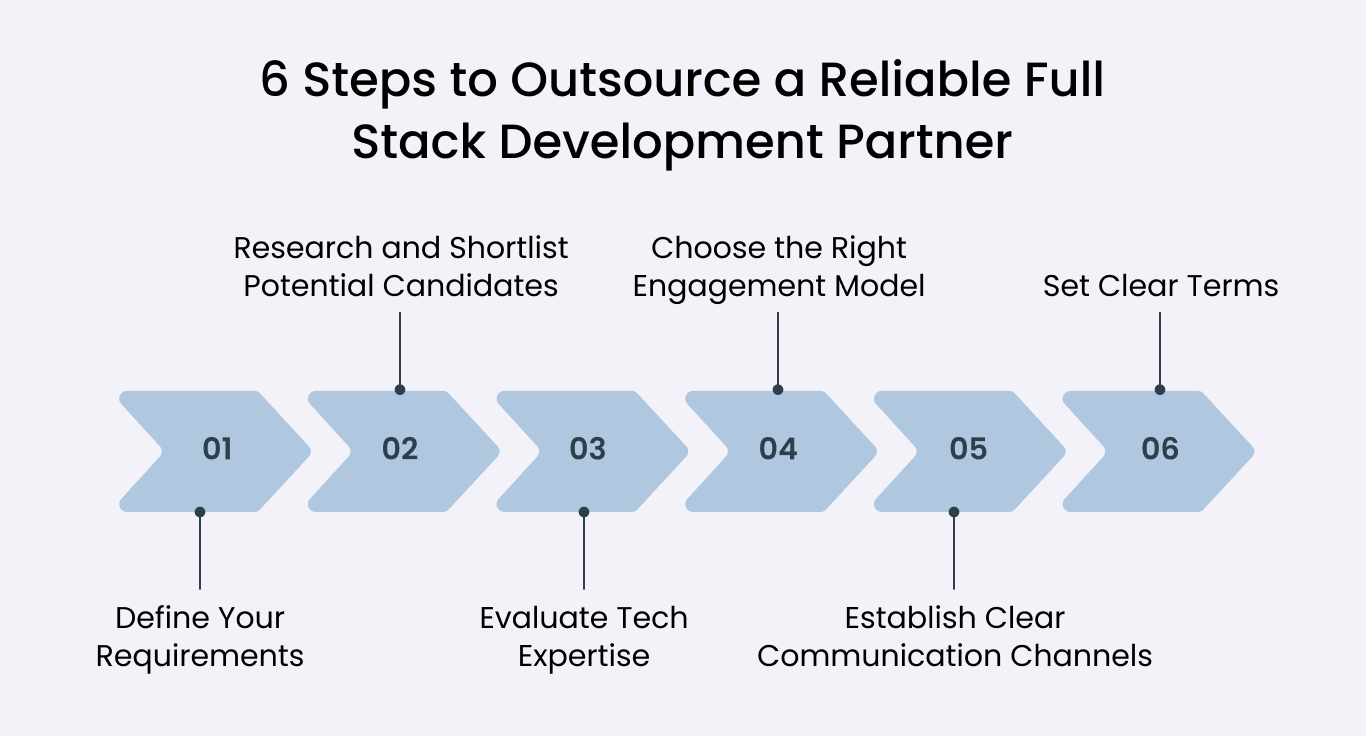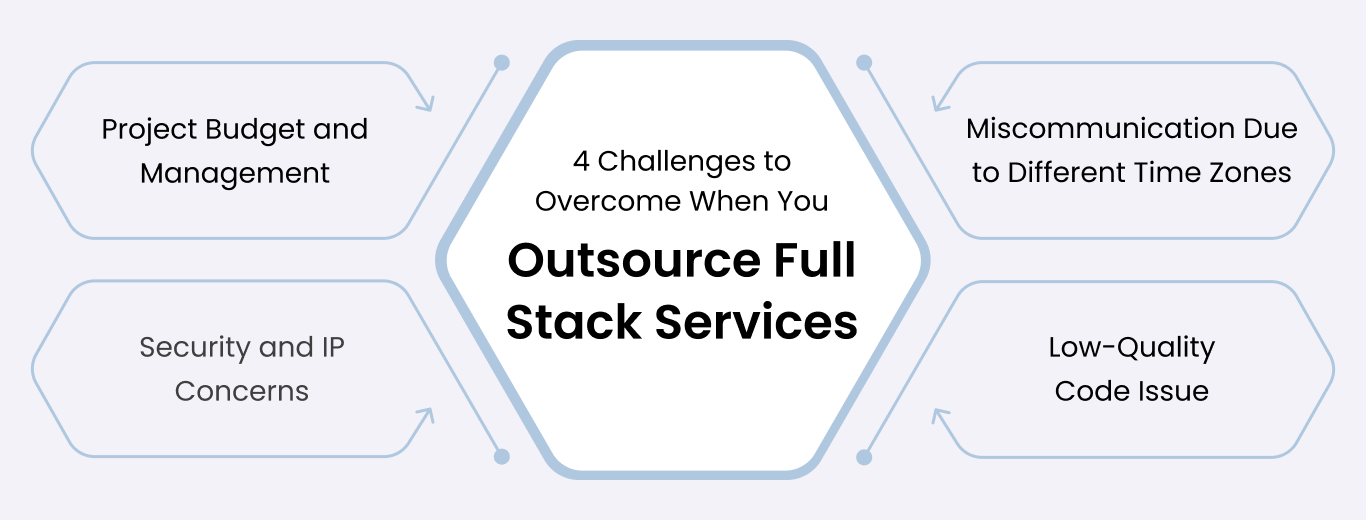Contents
You need a full-stack developer. Six months and dozens of interviews later, you’re still searching while your project deadline looms and competitors ship features faster. Sound familiar?
Here’s the reality: only 23% of developers consider themselves full-stack experts according to the Stack Overflow Developer Survey 2024. You’re competing for a tiny talent pool that commands premium salaries—if you can find them.
Full-stack development outsourcing changes everything. Instead of hunting for unicorns, you access complete development teams ready to build your production-ready web applications.
At Space-O Technologies, we’ve mastered this approach over 15+ years, delivering 300+ custom full-stack solutions using React, Node.js, Python, and modern cloud technologies.
-
Based on our extensive experience, this guide will walk you through:
- The key benefits of outsourcing to a full-stack development company
- Essential steps to outsource a full-stack web development service provider
- Common challenges you may face during full-stack outsourcing
- Popular outsourcing models to consider
Ready to learn how to hire the right full-stack development partner? Let’s dive in.
5 Benefits of Outsourcing Full Stack Development for Your Business

Outsourcing a full-stack development team is more than a cost-saving move. It can speed up deployment, improve product quality, and give you instant access to specialized skills.
1. Access to specialized expertise and a global talent pool
Outsourcing full-stack software development services provides immediate access to experienced teams specializing in modern technologies, including MEAN (MongoDB, Express.js, Angular, Node.js), MERN (MongoDB, Express.js, React, Node.js), etc.
These full-stack development teams have already invested years in mastering these technologies, something that would take months or years to develop in-house.
Hiring experienced full-stack developers from various regions or agencies provides access to their high-quality software skills and helps lighten the workload of deploying a top-performing application faster.
2. Save the development costs without compromising quality
Cost optimization is a significant reason businesses outsource full-stack development. Building an in-house team means investing in recruitment, employee benefits, office space, equipment, software licenses, and ongoing training.
Outsourcing to a full-stack development company eliminates these recruitment and training costs, saving you from extra expenses to upskill your in-house team. You can learn about software development costs before outsourcing to plan your budget wisely.
-
Comparison:
- A senior full-stack developer in the United States earns an average salary of around $130,000 per year, excluding an additional 30–40% overhead for benefits and infrastructure.
- In contrast, outsourcing to regions like Eastern Europe offers senior developers at $50–75 per hour while maintaining comparable quality standards.
This can translate to annual savings of $60,000–$100,000 per developer, gaining you expert talent without the in-house costs.
3. Faster time-to-market and accelerated development
Outsourcing full-stack development can significantly speed up your project delivery. Instead of spending weeks or months searching, hiring, and onboarding new developers, outsourcing IT partners can quickly put together a skilled team that’s ready to start work.
-
These full-stack development service providers bring:
- Immediate team availability to start development without recruitment delays
- Streamlined processes and proven methodologies that reduce development time
- Operational maturity and expert project management for smoother execution
By removing hiring bottlenecks and leveraging frontend and backend teams, you can launch your product faster and gain an edge over competitors.
4. Focus on core business activities
Outsourcing full-stack development frees your internal team to focus on high-value, strategic priorities instead of getting caught up in time-consuming technical execution.
This is especially valuable for startups and growing companies, where leadership time is best spent on activities such as product innovation, business growth, and customer relationships.
By offloading technical work to a skilled external team, your organization can maintain momentum, stay agile, and channel resources into areas that directly drive success.
5. Scalability and flexibility in resource management
Business needs change. Sometimes you need to ramp up development fast, and other times you need to scale back. Outsourcing full-stack development makes this easy, without the hiring delays or the stress of downsizing an in-house team.
An experienced outsourcing partner can quickly provide extra developers during peak phases and just as easily reduce resources during slower periods. This on-demand flexibility helps you stay agile, control costs, and respond to market changes without disruption.
In the next section, let’s learn how to find the right partner who offers software development consulting services and helps you deploy projects within the timeline and budget.
How to Outsource Full Stack Development in 6 Steps

Outsourcing full-stack development can streamline your project delivery and connect you with specialized talent worldwide. To ensure a smooth and successful partnership, follow these 8 essential steps that cover everything from defining your project needs to onboarding the right development team.
1. Define your project requirements and technical specifications
Before engaging with potential outsourcing partners, you need crystal-clear project requirements. This involves creating detailed documentation that covers functional requirements, technical specifications, user stories, and acceptance criteria.
Start by conducting stakeholder interviews to understand business objectives, user needs, and success metrics. Document these findings in a comprehensive project brief that includes:
- Target audience and user personas
- Key features and functionalities
- Integration requirements with existing systems
- Performance expectations and scalability needs
- Security and compliance requirements
A well-documented brief avoids misunderstandings and sets measurable expectations for success. This becomes the foundation for accurate estimates and relevant proposals from potential partners.
2. Research and shortlist potential outsourcing partners
Begin your partner search by exploring reputable platforms like Clutch, GoodFirms, and DesignRush. These platforms provide verified reviews, portfolio examples, and detailed company profiles.
Look for partners with specific experience in your industry and technology stack. A web development partner who has built similar applications will understand your challenges better and can provide valuable insights based on their previous projects.
Key evaluation criteria:
- Portfolio quality and project complexity
- Client testimonials and references
- Technical expertise in your required stack
- Industry experience and domain knowledge
- Communication capabilities and cultural fit
Thorough research like this ensures you only invest time in discussions with the most qualified candidates. The right shortlist will save time in evaluations later in the process.
3. Evaluate technical expertise and cultural fit
Technical evaluation should go beyond portfolio reviews. Here are the ways to evaluate each partner or team of developers:
- Request code samples to review quality and standards
- Conduct technical interviews with the actual project team
- Test communication, English proficiency (if applicable), and time zone overlap for real-time collaboration
- Check whether they are willing to accommodate overlap hours for real-time collaboration.
When an outsourced team is technically strong and culturally aligned, it delivers smoother collaboration. This synergy often results in faster problem-solving and higher overall quality.
4. Choose the right engagement model for your project
The engagement model you choose sets the tone for cost control, flexibility, and project success. In full‑stack development outsourcing, the three most common engagement models are:
| Engagement Model | Pros | Cons | Best For |
|---|---|---|---|
| Fixed Price Model (Predictable and Structured) | Budget certainty, defined timelines | Limited flexibility, extra costs for scope changes | Ideal for projects such as eCommerce platforms where requirements are clear and stable, with minimal expected changes |
| Time & Materials Model (Flexible and Adaptive) | Pay for actual hours/resources, adapt to evolving priorities | Requires hands-on project oversight to manage scope creep | Suited for complex or evolving projects where requirements change during development |
| Dedicated Team Model | Maximum control, higher productivity | Ideal for ongoing | |
| Long-Term and Deeply Integrated | Seamless collaboration, constant availability | Commitment required | Development, product scaling, and long-term enterprise projects |
If you expect changes or need agility, choose the time and materials model. If you’re looking for a strategic, embedded partner for a long-term project, consider hiring a dedicated developer team.
5. Establish clear communication protocols and project management
In outsourcing, effective communication is the glue that keeps projects on track. Without it, even the best technical skills can go to waste. Define your communication and management processes before the project begins.
Recommended rhythm:
- Daily stand-ups: Short updates from the development team
- Weekly progress reviews: Align with stakeholders on deliverables and blockers
- Sprint retrospectives: Track KPIs, budgets, and performance trends
- Quarterly relationship reviews: Evaluate long-term goals and collaborative quality
Essential communication tools:
- Instant messaging: Slack or Microsoft Teams
- Task and project tracking: Jira or Asana
- Code collaboration: GitHub or GitLab
- Video conferencing: Zoom or Google Meet
Establishing clear protocols prevents misunderstandings, creates accountability, and allows a faster development process, especially when working across time zones.
6. Sign comprehensive contracts and IP protection agreements
Legal protection is vital when outsourcing full-stack development work to safeguard your investment and intellectual property. Your contract should clearly define key terms and conditions that protect your interests and ensure a successful partnership.
Key contract elements to include:
- Scope and deliverables: Clearly state what work will be done, what features will be included, and what’s excluded to avoid misunderstandings.
- Timelines and milestones: Set specific deadlines and link them to deliverables to track progress effectively.
- Payment terms: Define when, how, and under what conditions payments will be made.
- Rights transfer: Ensure all code, designs, and assets belong to you once the project is completed.
- Change management: Outline how scope, timeline, or budget changes will be requested and approved.
- Service Level Agreements (SLAs): Set measurable standards for quality, performance, and support that the vendor must meet.
Here is the web app security and testing checklist to review before starting any collaboration.
To strengthen your legal protection, include a robust Non-Disclosure Agreement (NDA) to safeguard confidential information and proprietary ideas. Always ensure that all IP rights for the developed software are formally transferred to your organization once the project is completed and paid for.
Launch Your Full-Stack Product 3x Faster
Skip recruitment delays. Start your project with an experienced full-stack development team in just 7-14 days.

After the detailed steps on how to outsource full-stack development effectively, the natural next focus is on the potential challenges you may face during and after the outsourcing process. Understanding these common hurdles will help you proactively manage risks and make your outsourcing partnership more successful.
4 Challenges of Full Stack Development Outsourcing and (How to Overcome Them)

While outsourcing full-stack development can accelerate your project and expand your access to talent, it’s not without its difficulties. Being aware of the potential challenges up front will help you anticipate risks, set realistic expectations, and build a more successful outsourcing partnership.
1. Miscommunication due to a different time zone
Managing communication across different time zones remains one of the most significant challenges in outsourcing relationships.
- Establish overlapping working hours (minimum 3-4 hours daily)
- Use asynchronous communication tools effectively
- Create detailed documentation for project decisions
- Implement handoff procedures between time zones
- Schedule regular all-hands meetings during overlap hours
Solutions for effective time zone management:
2. Quality control and code standards maintenance
Maintaining consistent quality across distributed development teams requires deliberate effort and systematic approaches. Without proper controls, you risk receiving code that doesn’t meet your standards or integrate well with existing systems.
- Implement automated code quality checks using tools like ESLint
- Establish mandatory code review processes
- Create comprehensive testing strategies with a minimum of 80% code coverage
- Define and enforce coding standards and best practices
- Conduct regular technical audits and assessments
Quality assurance strategies:
3. Intellectual property protection and security concerns
Protecting your intellectual property and sensitive data when working with external teams requires careful planning and robust security measures.
- Implement comprehensive security protocols and access controls
- Use encrypted communication channels and secure code repositories
- Conduct regular security audits and vulnerability assessments
- Establish clear data handling and retention policies
- Use legal protections, including NDAs and liability clauses
Security best practices:
4. Project scope management and budget control
Without proper scope management, projects can exceed budgets and timelines significantly.
- Establish transparent change management processes
- Require written approval for all scope modifications
- Use agile development methodologies for controlled flexibility
- Implement regular budget monitoring and reporting
- Create early warning systems for potential overruns
Scope management strategies:
Understanding the standard outsourcing models helps you choose the best approach tailored to your project’s size, scope, and business needs. You can go on trial-error mode or build an MVP first to try the tech expertise of an agency. Here is the guide on MVP development for startups that lets you understand whether to approach a company.
In the following section, we’ll explore popular models like onshore, offshore, nearshore, and engagement types such as fixed price, dedicated teams, and time & materials.
4 Popular Models for Full Stack Development Outsourcing
Choosing the right outsourcing model can make the difference between smooth collaboration and constant friction. Below are the four most common models, each with its strengths, trade‑offs, and ideal use cases.
1. Offshore outsourcing model
This outsourcing model involves partnering with offshore development teams in distant countries, typically offering the most significant cost savings. Popular offshore destinations include India, Poland, and the Philippines.
- Time zone differences: Can enable 24-hour development cycles
- Large talent pools: Access to specialized expertise
- Cultural considerations: May require adaptation and understanding
Key characteristics:
Best suited for:Cost-conscious projects with well-defined requirements and flexible timelines.
2. Nearshore outsourcing model
This outsourcing model involves partnering with nearshore development company in nearby countries or regions, offering a balance between cost savings and communication convenience.
- Time zone alignment: Within 1-4 hours, typically
- Cultural compatibility: Better understanding of business practices
- Communication ease: Real-time collaboration capabilities
Key characteristics:
Best suited for: Projects requiring frequent stakeholder input or complex decision-making processes.
3. Onshore outsourcing model
Onshore outsourcing involves working with teams in the same country but outside your immediate geographic area.
- Communication: Maximum convenience and cultural alignment
- Compliance: Easier regulatory and legal framework management
- Quality control: Higher oversight and control capabilities
Key characteristics:
Best suited for: Projects with strict regulatory requirements or sensitive data handling needs.
4. Hybrid outsourcing model
Many organizations adopt hybrid approaches that combine elements from different models.
- Flexibility: Optimize different components based on requirements
- Risk mitigation: Distribute risks across multiple partners
- Cost optimization: Balance cost and quality for different project aspects
- Complexity: Requires sophisticated project management
Key characteristics:
Best suited for: Large, complex projects with varying requirements for different components.
Need Help to Choose the Right Outsourcing Model?
Our software development consultants help you find the right outsourcing model based on your project scope, goals, and budget.
Outsource Space-O Technologies’ Dedicated Team for Your Full‑Stack Project
Now you understand the essentials of full‑stack development outsourcing, from choosing the right model to managing communication, quality, security, and budgets effectively.
With the right partner, you can reduce costs significantly, access world‑class talent, and stay fully focused on scaling your product and business.
The next step? Collaborate with Space-O Technologies, a custom software development company that has consistently delivered innovative, high‑quality solutions to clients worldwide.
At Space-O Technologies, we offer:
- Pre-vetted full-stack developers with expertise in modern technologies
- Agile workflows for faster time-to-market and adaptability
- Robust security practices with complete data confidentiality
- Post-launch support & maintenance to ensure product stability
Let’s discuss how our team can bring your vision to a fully-fledged software or application based on your timeline, budget, and expectations.
Build Your Full-Stack Project With the Top Tech Talent
No more hunting for full-stack unicorns. Get vetted experts ready to deliver production-ready solutions— from MVP to enterprise-grade applications.
FAQ About Outsourcing a Full Stack Development
What is full-stack development?
Full stack development is the process of designing, building, and maintaining a complete web application that covers both the front end (user interface) and back end (server, database, and application logic) parts. A full-stack developer is skilled in all layers of this development lifecycle and can manage both client side and server side tasks.
What are the potential risks of outsourcing?
Outsourcing carries risks such as communication barriers, quality inconsistencies, security and intellectual property vulnerabilities, scope creep, and budget overruns. Managing these challenges requires clear communication, strict quality control, solid legal agreements, thorough planning, and continuous monitoring throughout the project.
How much does it cost to outsource a full-stack developer?
The cost of outsourcing full-stack development varies between $25,000 and $200,000 for smaller to medium-sized projects. For complex or enterprise-grade applications, the price may go beyond this range, depending on project complexity, features and functionality, project timeline, location, tech stack, and other integration requirements.
How do I communicate effectively with an outsourced development team?
Most successful projects use daily video calls, project management tools like Jira or Trello, and instant messaging platforms. Establish clear communication schedules, define response time expectations, and collaborate with comprehensive documentation tools. Good outsourcing partners typically provide dedicated project managers to bridge any communication gaps.
How long does it take to start working with an outsourced team?
Most established outsourcing companies can assemble and deploy development teams within 2-4 days after contract signing. This includes team selection, project setup, environment preparation, and initial sprint planning. The timeline depends on project complexity and the onboarding framework of your vendor. With SpaceO Technologies, it will take 1-2 weeks to onboard the right development team.
What’s the minimum project size worth outsourcing?
Most outsourcing makes sense for projects requiring 2+ months of development work or budgets exceeding $25,000. Smaller projects often have too much communication overhead relative to development time. However, some companies offer fixed price packages for standard applications like MVPs or simple web platforms.
Can I scale my outsourced team size during the project?
Yes, this is one of outsourcing’s key advantages. You can easily add 2-5 developers during peak development phases or scale down during maintenance periods. Good partners maintain bench strength and can accommodate team size changes within days, providing flexibility that’s impossible with in-house hiring.



